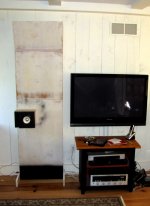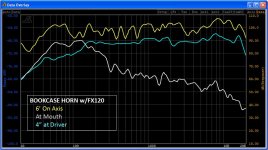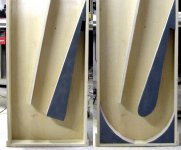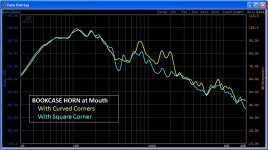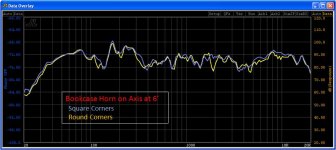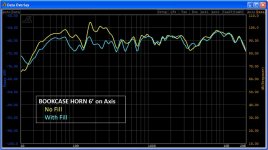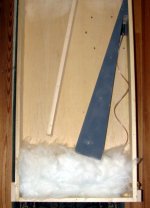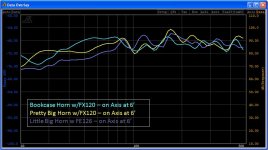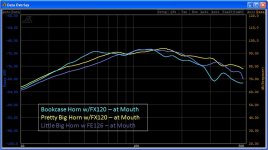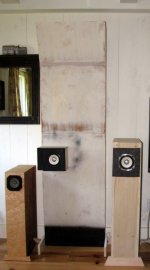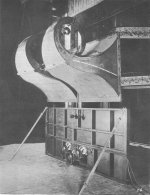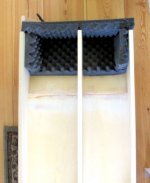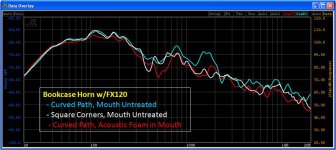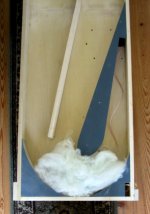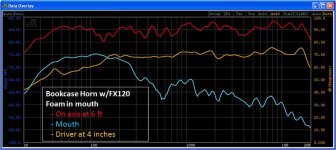This is looking really cool. I thought of doing something similar for a subwoofer. Being fat and fifty however I find bottom shelves almost useless so my plan was to have the horn or TL output at the bottom with a tasteful grill cloth cover. In my current house however I can use the attached garage for the bulk of the horn so I won't need to use that approach here.
Look forward to seeing your finished project.
Look forward to seeing your finished project.
Well, I've got one speaker complete (except for the bookcase part) and upstairs in my family room. It's pretty imposing in the flesh and in the living area. I've included a photo of the speaker in place in my family room. My wife is having some trouble imagining it as one of two nice looking bookcases in her family room. She's giving me a little bit of a stink eye. Time will tell.
I've only got the one built so my listening has been limited to one channel stereo and not much of that. It sounds good with with good bass. I will do more listening today and do some comparisons against my Pretty Big Horn from a couple years ago with the same FX120 driver.
I have made a lot of measurements with my Smith and Larson Speaker Tester. This is a great tool. I've included the measurements of the speaker as it stands now. It's pretty consistent with the simulations. I've made some significant design changes, but more on that in my next post.
I've only got the one built so my listening has been limited to one channel stereo and not much of that. It sounds good with with good bass. I will do more listening today and do some comparisons against my Pretty Big Horn from a couple years ago with the same FX120 driver.
I have made a lot of measurements with my Smith and Larson Speaker Tester. This is a great tool. I've included the measurements of the speaker as it stands now. It's pretty consistent with the simulations. I've made some significant design changes, but more on that in my next post.
Attachments
Has anyone seen something similar?
Yes, though this is the only one I've seen on-line: retro vintage modern hi-fi: January 2011
GM
Good reasons why a single good woofer is better than two. And going to two (or more) to control room resonances and still playing the same mixed bass signal, they should never be placed in the familiar symmetrical way anyways.
With the woofer up front, prolly no problem crossing over not far below 180 Hz. Which makes it easy to produce speakers to handle the rest.
A lot of people who never tried this (or didn't do it blind) will be outraged at the suggestion.
With the woofer up front, prolly no problem crossing over not far below 180 Hz. Which makes it easy to produce speakers to handle the rest.
A lot of people who never tried this (or didn't do it blind) will be outraged at the suggestion.
Last edited:
Square coreners or curved corners?
My initial drawings show the internals with carefully curved folds that pretty faithfully implement the simulated expansion. I wanted to take the opportunity to make measurements to see if it was worth the effort in a back loaded horn. This topics has been the subject of numerous threads but I've not seen measurements.
Here are the arguments I've seen made:
For Square Corners - the only argument I've seen made is that the square corners in the folds will attenuate the mid range and highs while it would not significantly affect the lows because the wavelengths are too long (100 Hz has a wavelength of ~ 11 feet) to be affected. You don't want mids and highs making it out the moth of a back loaded horn because they will interact with the mids and highs from the front of the speaker with negative results.
For Round Corners - I've seen several arguments made for curved corners:
1. Square corners will affect the low frequencies and cause problems with the low frequency response at the mouth of the BLH. Curved corners will minimize this.
2. Curved corners will improve the efficiency of the BLH.
3. The square corners will reflect mids and highs back through the throat and to the back of the driver, affecting the direct output from the front of the driver.
4. Square corners will distort the sound coming from the horn.
I've got to confess, I was hoping that the curved expansion would have benefits or at least break even. I find the curves esthetically pleasing and I enjoyed the woodworking challenge of making them.
The Test:
My design has two folds; a 90 degree at the throat and a 180 degree fold at the floor. I built the speaker with both curved corners and square corners, see the attached picture. Everything else is exactly the same: the same driver and everything except the corners are unchanged.
I then made measurements of frequency response and distortion at both the mouth of the BLH and at the front of the speaker. I was very careful to keep the speaker positions exactly the same (against a wall, about 8 ft from a corner), the mike positions exactly the same, and the amplifier gain unchanged.
The Results:
The square corners performed better.
The graph comparing the response at the mouth shows nasty spikes at ~800, 1500 and 2000 Hz for the curved version. This surprised me since one of the arguments FOR the curves was that it wouldn't have this problem.
There is no difference in the bass level, so the curves didn't help that.
There is no overall lower level for the mids and highs with the square corners so, at least for my design, the square corners did not help this.
There was no difference in distortion at the mouth or at the listening position. Sorry, but I lost the graphs for this.
The responses on axis at 6' are virtually indistinguishable (see attached picture) but those spikes at the mouth can't be helping anything.
I'm moving forward with square corners. It kills me to do this but I'm an engineer and I have to go with what the numbers are telling me.
My initial drawings show the internals with carefully curved folds that pretty faithfully implement the simulated expansion. I wanted to take the opportunity to make measurements to see if it was worth the effort in a back loaded horn. This topics has been the subject of numerous threads but I've not seen measurements.
Here are the arguments I've seen made:
For Square Corners - the only argument I've seen made is that the square corners in the folds will attenuate the mid range and highs while it would not significantly affect the lows because the wavelengths are too long (100 Hz has a wavelength of ~ 11 feet) to be affected. You don't want mids and highs making it out the moth of a back loaded horn because they will interact with the mids and highs from the front of the speaker with negative results.
For Round Corners - I've seen several arguments made for curved corners:
1. Square corners will affect the low frequencies and cause problems with the low frequency response at the mouth of the BLH. Curved corners will minimize this.
2. Curved corners will improve the efficiency of the BLH.
3. The square corners will reflect mids and highs back through the throat and to the back of the driver, affecting the direct output from the front of the driver.
4. Square corners will distort the sound coming from the horn.
I've got to confess, I was hoping that the curved expansion would have benefits or at least break even. I find the curves esthetically pleasing and I enjoyed the woodworking challenge of making them.
The Test:
My design has two folds; a 90 degree at the throat and a 180 degree fold at the floor. I built the speaker with both curved corners and square corners, see the attached picture. Everything else is exactly the same: the same driver and everything except the corners are unchanged.
I then made measurements of frequency response and distortion at both the mouth of the BLH and at the front of the speaker. I was very careful to keep the speaker positions exactly the same (against a wall, about 8 ft from a corner), the mike positions exactly the same, and the amplifier gain unchanged.
The Results:
The square corners performed better.
The graph comparing the response at the mouth shows nasty spikes at ~800, 1500 and 2000 Hz for the curved version. This surprised me since one of the arguments FOR the curves was that it wouldn't have this problem.
There is no difference in the bass level, so the curves didn't help that.
There is no overall lower level for the mids and highs with the square corners so, at least for my design, the square corners did not help this.
There was no difference in distortion at the mouth or at the listening position. Sorry, but I lost the graphs for this.
The responses on axis at 6' are virtually indistinguishable (see attached picture) but those spikes at the mouth can't be helping anything.
I'm moving forward with square corners. It kills me to do this but I'm an engineer and I have to go with what the numbers are telling me.
Attachments
Other measurements
I've attached a picture showing the response with fiber fill and another showing where the fill went. It made a pretty substantial improvement and I'm going to keep it, though there is a chance I'll experiment some more with placement and amount. The main detriment to experimentation is that there are about 30 screws holding on the back and it's a pain to take it off and put it back on.
I said it has good bass and I've attached graphs comparing the bass output, at the mouth and on axis at 6', for the Bookcase Horn and my Pretty Big Horn w/FX120 and my Little Big Horn w/FE126 from a couple years ago. Depending on which graph you look at, The Bookcase Horn picks up 20-25 Hz on the low end.
One final note on the various charts showing response on axis at 6': The bass response is very dependent on speaker position and mike position. To some extent, I'm measuring the room as much as the speakers. Once I started taking measurements I was locked into both speaker and mike positions because I wanted all the measurements to be comparable.
I've attached a picture showing the response with fiber fill and another showing where the fill went. It made a pretty substantial improvement and I'm going to keep it, though there is a chance I'll experiment some more with placement and amount. The main detriment to experimentation is that there are about 30 screws holding on the back and it's a pain to take it off and put it back on.
I said it has good bass and I've attached graphs comparing the bass output, at the mouth and on axis at 6', for the Bookcase Horn and my Pretty Big Horn w/FX120 and my Little Big Horn w/FE126 from a couple years ago. Depending on which graph you look at, The Bookcase Horn picks up 20-25 Hz on the low end.
One final note on the various charts showing response on axis at 6': The bass response is very dependent on speaker position and mike position. To some extent, I'm measuring the room as much as the speakers. Once I started taking measurements I was locked into both speaker and mike positions because I wanted all the measurements to be comparable.
Attachments
Last edited:
The graph comparing the response at the mouth shows nasty spikes at ~800, 1500 and 2000 Hz for the curved version. This surprised me since one of the arguments FOR the curves was that it wouldn't have this problem.
There is no overall lower level for the mids and highs with the square corners so, at least for my design, the square corners did not help this.
These are most likely mouth termination issues that can be dealt with by edge damping. The curves just facilitated them getting back to modulate the throat much more efficiently.
Hmm, the square corners did lower the level over a wide BW Vs the curved horn had it been 'ideal', but being truncated, only over a relatively narrow BW. By comparison, the various early W.E. horn's gain BW is so wide/efficient that the driver designed for them doesn't have a rear cover per se to keep its output from audibly comb filtering with its mouth output, only a bug screen/~aperiodic cooling vent to roll it off a bit more [for scale, those are 18" woofers]:
GM
Attachments
GM - you are right, of course, that in the range of the spikes the square edge version has a lower output. I was thinking of the spikes as a separate issue, not directly related to the reduction of mids/highs.
Where would I put the edge damping? At the edges of the mouth or the throat? What would you suggest I damp it with?
Where would I put the edge damping? At the edges of the mouth or the throat? What would you suggest I damp it with?
Normally one would fold it over the mouth rim ala Peavey, but for a bass horn it could be just on the inner 'lip' and extend up/down from the edge some distance, though not sure how much since my way of dealing with it is to 'kill two birds with one stone' by making a vent screen lined with 1" fiberglass acoustic insulation.
No clue what density open cell foam is required, I just know that what I use is good down to ~250 Hz, making it almost overkill for damping Altec 800 Hz cast alum. horns when used down to 800 Hz: http://www.lansingheritage.org/images/altec/specs/home-systems/878a-santiago/page2.jpg
GM
No clue what density open cell foam is required, I just know that what I use is good down to ~250 Hz, making it almost overkill for damping Altec 800 Hz cast alum. horns when used down to 800 Hz: http://www.lansingheritage.org/images/altec/specs/home-systems/878a-santiago/page2.jpg
GM
Normally one would fold it over the mouth rim ala Peavey, but for a bass horn it could be just on the inner 'lip' and extend up/down from the edge some distance, though not sure how much since my way of dealing with it is to 'kill two birds with one stone' by making a vent screen lined with 1" fiberglass acoustic insulation.
GM
I've decided to go back to the curved expansion and do some testing of acoustic insulation in the mouth as GM suggested. I didn't have the rigid fiberglass GM talked about but I did have some 2" acoustic foam that appears, from some searching, to be roughly equivalent to 1" Owens Corning 703 rigid fiberglass.
The first picture shows the foam pieces I used to both line the end of the mouth and a piece that covers the entire mouth opening. The second picture shows the results at the mouth. It compares the original curved path with no mouth treatment (notice the spikes at 800 and 1800 hz), the square corners version with no mouth treatment, and lastly the curved path version with the pictured mouth treatment. The last two curves seem to be roughly equivalent, with the mouth treatment a little better around 500 hz and a little worse around 1800. None of these are with any additional fiber stuffing.
I've decided to go for the curved expansion with the mouth treatment - it's actually easier since I already have all the curvy bits cut. I'm not sure I would go through the trouble if I was starting fresh. I put about half of the fiber stuffing back in. Only half because the last stuffing test showed a quite large decline in bass response. The third picture shows where the stuffing went. The fourth picture is a summary showing the response at the mouth, the driver and 6ft on axis. This is for the speaker with the mouth treatment and the fiber stuffing.
I'm pretty happy with this. Now on to building a book case around it.
Attachments
- Status
- This old topic is closed. If you want to reopen this topic, contact a moderator using the "Report Post" button.
- Home
- Loudspeakers
- Full Range
- Big BLH in Bookcase?
